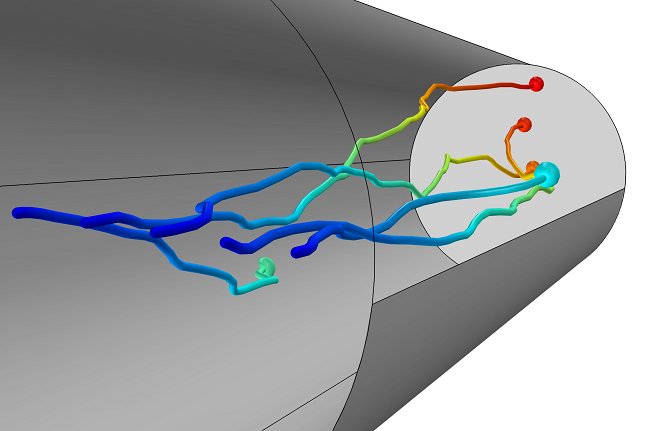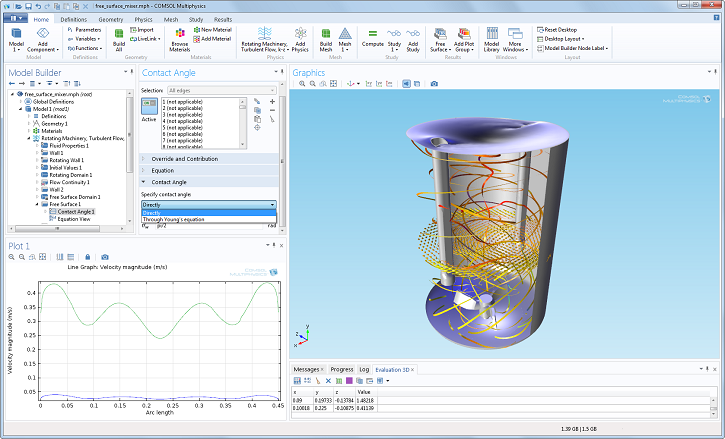
You’ve seen glimpses of our new software release at the COMSOL Conference and perhaps engaged in commentary around it in social media. Today marks the official release of COMSOL Multiphysics version 4.4, and you can now learn about the software updates in detail and download it if you are on subscription.
COMSOL 4.4 Brings a Fresh Look and Feel
So far, the most buzz has been around the updated COMSOL Desktop user interface (UI), with its ribbon design and new Multiphysics node. We’re very excited to introduce this new UI, as we think it’s going to improve your modeling process by providing a clearer overview of your workflow and just overall being more intuitive to use. By only displaying commands when you need them, the ribbon will make it easier for you to find the operations you are looking for to set up your models and run your simulations.

New UI: Ribbon in COMSOL Multiphysics version 4.4.
If you’re curious as to why we decided to update the UI and what this means for you, check out our previous blog post on thePhilosophy of the Ribbon.
Some other important news items that benefit all users are: a new hover-and-click selection method, auto-complete search tool for variables, user-defined geometric primitives, if/else statements in the model tree for conditional geometry creation, NASTRAN-mesh file export, and time-unit handling in the solvers.
Functionality Enhancements Across the Product Suite
In addition to the new UI, we have made a number of functionality enhancements across the existing products. For instance, a new boundary condition has been included in the CFD Module for the modeling of wall roughness for turbulent flow. An Outlet boundary condition is now also available, which will provide much more accurate mass and energy conservation for laminar flow, in addition to convergence that is both quicker and more robust. We also have news for our mechanical products; in terms of the Heat Transfer Module, there are new tools for modeling bioheating, the thermoelectric effect, and radiation. With COMSOL 4.4, the Structural Mechanics Module gives you easy access to gravity and Rotordynamic forces, new easier ways to couple shells with solids, as well as a new fast penalty method for mechanical contact. In the Acoustics Module, you will find the Linearized Euler equations for aeroacoustics simulations.
For electrical applications, the AC/DC Module is now equipped with a brand new nonlinear magnetic material library containing 165 materials, and the Wave Optics Module has built-in capabilities for simulating laser heating. In the RF Module, ports can be assigned to interior boundaries. This is a feature that was available in version 3.5a and long-term users will now be happy to know it has been reintroduced. If you’re using the Particle Tracing Module, you will be excited to hear that there is a new efficient method for solving particle-field and fluid-particle interactions with two-way coupling capabilities. The Optimization Module contains two new methods: one gradient-free method (BOBYQA) for dimensional optimization and another gradient-based method (MMA) for topology optimization. And the list goes on. Be sure to check out theRelease Highlights pagefor the full scope of updates.

Particle Tracing: Plotting argon ion trajectories in a drift tube.
New Add-On Module for CFD
For the folks out there looking to simulate stirred mixers and reactors, we have introduced a Mixer Module as an add-on to the CFD Module. With this new addition to the Product Suite, you can simulate fluid flow in rotating machinery with turbulent, laminar, non-isothermal, and non-Newtonian flow with and without taking free surfaces into consideration. With this add-on, you will be able to also simulate the concentration, velocity, and temperature profiles in mixers from an array of industrial processes, including manufacturing of pharmaceuticals, consumer products, and food. When designing mixers, it’s important to account for mixing efficiency, the impeller pumping number, and power draw. The Mixer Module will show you results on these and other quantities pertinent to mixing.

Mixer Module: Model mixers and stirred vessels.
If you need to simulate impeller and mixer designs, you should take a closer look at theMixer Module section of the Release Highlights.
Video and Complete Details on COMSOL Multiphysics Version 4.4
As usual, we have prepared a Release Highlights page where you can dive into all of the new updates and watch a video. Catch the details on theCOMSOL 4.4 Release Highlights page.
Continue to check back on the blog for more in-depth information on specific aspects of the new software release!



Comments (0)